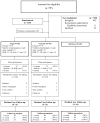A randomized trial comparing yoga, stretching, and a self-care book for chronic low back pain
- PMID: 22025101
- PMCID: PMC3279296
- DOI: 10.1001/archinternmed.2011.524
A randomized trial comparing yoga, stretching, and a self-care book for chronic low back pain
Abstract
Background: Chronic low back pain is a common problem lacking highly effective treatment options. Small trials suggest that yoga may have benefits for this condition. This trial was designed to determine whether yoga is more effective than conventional stretching exercises or a self-care book for primary care patients with chronic low back pain.
Methods: A total of 228 adults with chronic low back pain were randomized to 12 weekly classes of yoga (92 patients) or conventional stretching exercises (91 patients) or a self-care book (45 patients). Back-related functional status (modified Roland Disability Questionnaire, a 23-point scale) and bothersomeness of pain (an 11-point numerical scale) at 12 weeks were the primary outcomes. Outcomes were assessed at baseline, 6, 12, and 26 weeks by interviewers unaware of treatment group.
Results: After adjustment for baseline values, 12-week outcomes for the yoga group were superior to those for the self-care group (mean difference for function, -2.5 [95% CI, -3.7 to -1.3]; P < .001; mean difference for symptoms, -1.1 [95% CI, -1.7 to -0.4]; P < .001). At 26 weeks, function for the yoga group remained superior (mean difference, -1.8 [95% CI, -3.1 to -0.5]; P < .001). Yoga was not superior to conventional stretching exercises at any time point.
Conclusion: Yoga classes were more effective than a self-care book, but not more effective than stretching classes, in improving function and reducing symptoms due to chronic low back pain, with benefits lasting at least several months.
Trial registration: clinicaltrials.gov Identifier: NCT00447668.
Figures
Comment in
-
Comparative effectiveness studies in chronic low back pain: progress and goals.Arch Intern Med. 2011 Dec 12;171(22):2026-7. doi: 10.1001/archinternmed.2011.519. Epub 2011 Oct 24. Arch Intern Med. 2011. PMID: 22025099 No abstract available.
References
-
- Haldeman S, Dagenais S. What have we learned about the evidence-informed management of chronic low back pain? Spine J. 2008 Jan–Feb;8(1):266–277. - PubMed
-
- Chou R, Huffman LH. Nonpharmacologic therapies for acute and chronic low back pain: a review of the evidence for an American Pain Society/American College of Physicians clinical practice guideline. Ann Intern Med. 2007 Oct 2;147(7):492–504. - PubMed
-
- Galantino ML, Bzdewka TM, Eissler-Russo JL, et al. The impact of modified Hatha yoga on chronic low back pain: a pilot study. Altern Ther Health Med. 2004 Mar–Apr;10(2):56–59. - PubMed
-
- Williams KA, Petronis J, Smith D, et al. Effect of Iyengar yoga therapy for chronic low back pain. Pain. 2005 May;115(1–2):107–117. - PubMed
-
- Sherman KJ, Cherkin DC, Erro J, Miglioretti DL, Deyo RA. Comparing yoga, exercise, and a self-care book for chronic low back pain: a randomized, controlled trial. Ann Intern Med. 2005 Dec 20;143(12):849–856. - PubMed



